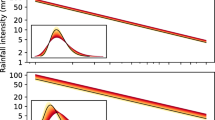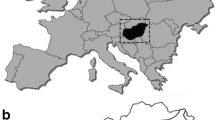Summary
Trends in climate time series are habitually estimated on the basis of the least-squares method. This estimator is optimal if the residuals follow the Gaussian distribution. Unfortunately, only a small number of observed climate time series fulfil this assumption. This work introduces a robust method for trend analyses of non-Gaussian climate variables. Robust trend analyses as well as probability assessments of extreme events (Trömel and Schönwiese 2006) represent an application of the generalized time series decomposition technique. Trömel (2005) and Trömel and Schönwiese (2005) applied this decomposition technique to monthly precipitation sums from a German station network of 132 time series covering 1901–2000 in order to achieve a statistical modeling of the time series. The time series under consideration can be interpreted as a realization of a Gumbel-distributed random variable with time-dependent scale and location parameter. More precisely, each observed value can be seen as one possible realization of the estimated probability density function (PDF) with the location and the scale parameter of the respective time step. Consequently, the expected value of the Gumbel-distributed random variable can be estimated for every time step of the observation period and the statistical modeling represents an alternative approach to estimate trends in observational precipitation time series. The method is robust with respect to observed high precipitation values. The influence of relatively high precipitation sums is not larger than justified from a statistical point of view and changes in all parameters (here location and scale parameter) of the distribution can be taken into account. Monte-Carlo-simulations demonstrate the smaller mean squared error of the trend estimator using the statistical modeling. The least-squares estimator often shows a positive bias, while the method introduced provides robust monthly trend estimates taken into account the statistical characteristics of precipitation.
Similar content being viewed by others
References
J Grieser S Trömel C-D Schönwiese (2002) ArticleTitleStatistical time series decomposition into significant components and application to European temperature Theor Appl Climatol 71 171–183 Occurrence Handle10.1007/s007040200003
PJ Huber (1981) Robust statistics Wiley Series in Probability and Mathematical Statistics New York 328
IPCC (2001) Climate change 2001: the scientific basis. In: Houghton JT et al. (eds) Contribution of working group 1 to the third assessment report of the IPCC. Cambridge University Press, Cambridge, 882 pp
Rapp J, Schönwiese C-D (1996) Atlas der Niederschlags- und Temperaturtrends in Deutschland 1891–1990. Frankfurt: Frankfurter Geowissenschaftliche Arbeiten, Serie B, Band 5, 255 pp
H Rinne (1997) Taschenbuch der Statistik Verlag Harri Deutsch Thun/Frankfurt 650
PJ Rousseeuw AM Leroy (1987) Robust regression and outlier detection Wiley Series in Probability and Mathematical Statistics New York 329
C-D Schönwiese (2006) Praktische Statistik EditionNumber4 Borntraeger Berlin Stuttgart
K Schrader T Hettmansperger (1980) ArticleTitleRobust analysis of variance upon a likelihood ratio criterion Biometrika 67 93–101 Occurrence Handle10.1093/biomet/67.1.93
HV Storch FW Zwiers (1999) Statistical analysis in climate research Cambridge University Press Cambridge 484
Trömel S (2005) Statistische Modellierung monatlicher Niederschlagszeitreihen (doctorate thesis). Frankfurt: Report No. 2, Institute for Atmosphere and Environment, Johann Wolfgang Goethe University, 238 pp
S Trömel C-D Schönwiese (2005) ArticleTitleA generalized method of time series decomposition into significant components including probability assessments of extreme events and application to observational German precipitation data Met Z 14 417–427 Occurrence Handle10.1127/0941-2948/2005/0039
S Trömel C-D Schönwiese (2006) ArticleTitleProbability change of extreme precipitation observed 1901–2000 in Germany Theor Appl Climatol 876 29–39
Author information
Authors and Affiliations
Corresponding author
Additional information
Correspondence: Silke Trömel, Meteorological Institute of the University Bonn, Auf dem Hügel 20, D-53121 Bonn, Germany
Rights and permissions
About this article
Cite this article
Trömel, S., Schönwiese, C. Robust trend estimation of observed German precipitation. Theor Appl Climatol 93, 107–115 (2008). https://doi.org/10.1007/s00704-007-0341-1
Received:
Accepted:
Published:
Issue Date:
DOI: https://doi.org/10.1007/s00704-007-0341-1




